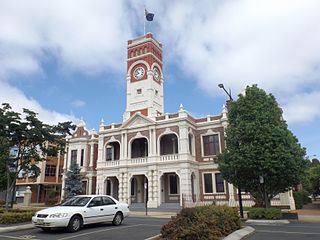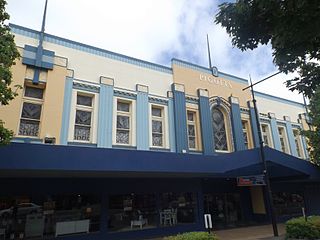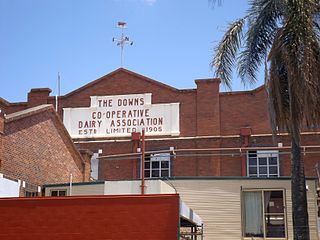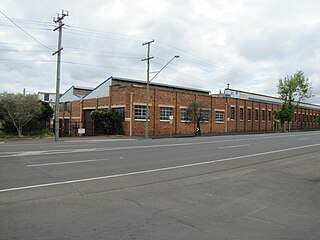
Toowoomba is a city in the Toowoomba Region of the Darling Downs, Queensland, Australia. It is 125 km (78 mi) west of Queensland's capital city Brisbane by road. The urban population of Toowoomba as of the 2021 census was 142,163, having grown at an average annual rate of 1.45% over the previous two decades. Toowoomba is the second-most-populous inland city in the country after the nation's capital of Canberra, and hence the largest city on the Darling Downs. It is the third largest regional centre in Queensland, often referred to as the capital of the Darling Downs.
Banking in Australia is dominated by four major banks: Commonwealth Bank, Westpac, Australia & New Zealand Banking Group and National Australia Bank. There are several smaller banks with a presence throughout the country, and a large number of other financial institutions, such as credit unions, building societies and mutual banks, which provide limited banking-type services and are described as authorised deposit-taking institutions (ADIs). Many large foreign banks have a presence, but few have a retail banking presence. The central bank is the Reserve Bank of Australia (RBA). The Australian government’s Financial Claims Scheme (FCS) guarantees deposits up to $250,000 per account-holder per ADI in the event of the ADI failing.
The Cobb & Co Museum is at 27 Lindsay Street, Toowoomba, Queensland, Australia.
The modern history of Toowoomba begins in the 19th century. Europeans began exploring and settling in the area from 1816 on-wards. By the end of the 1840s the rich lands around Toowoomba were being used for agriculture. 12 suburban allotments at Drayton were surveyed in 1849. Small commercial settlements were growing with schools and churches also being built. The first council election took place in 1861 and the telegraph connection to Brisbane was established in 1862. Between 1868 and 1886, several new railway lines from Toowoomba were opened. Throughout the 21st century the city prospered with new hospitals, large industrial buildings and education facilities established. Toowoomba Wellcamp Airport was opened in 2014.
Glenvale is a rural locality in the Toowoomba Region, Queensland, Australia. It is a suburb of Toowoomba. In the 2016 census, Glenvale had a population of 6,353 people.

Pittsworth is a rural town and locality in the Toowoomba Region, Queensland, Australia. In the 2016 census, the locality of Pittsworth had a population of 3,294 people.
Suncorp Group Limited is an Australian finance, insurance, and banking corporation based in Brisbane, Queensland, Australia. It is one of Australia's mid-size banks and its largest general insurance group, formed on 1 December 1996 by the merger of Suncorp, Metway Bank and the Queensland Industry Development Corporation (QIDC).
The 1893 banking crisis in the Australian colonies involved the collapse of a considerable number of commercial banks and building societies, and a general economic depression. It occurred at the same time as the US Panic of 1893 (1893–1897).

Toowoomba City is an urban locality in the Toowoomba Region, Queensland, Australia. It is the central suburb of Toowoomba, containing its central business district. In the 2016 census, Toowoomba City had a population of 2,088 people.

Harlaxton is a locality in the Toowoomba Region, Queensland, Australia. In the 2016 census, Harlaxton had a population of 2,547 people. Traditionally a rural area, most of the locality is now residential.

St Luke's Anglican Church is a heritage-listed church at 152 Herries Street, Toowoomba City, Queensland, Australia. It is the second church on the site and was designed by John Hingeston Buckeridge and built in 1897. It is also known as St Luke's Church of England. It was added to the Queensland Heritage Register on 28 July 2000.

Defiance Flour Mill is a heritage-listed mill at 269-291 Ruthven Street, Toowoomba, Toowoomba Region, Queensland, Australia. It was designed by Toowoomba architect William Hodgen and built in 1911 by WT Smith. It was added to the Queensland Heritage Register on 26 February 2002.

The Exchange Building is a heritage-listed commercial building at 245-253 Margaret Street, Toowoomba City, Toowoomba, Toowoomba Region, Queensland, Australia. It consists of two storeys, with a row of four shops on the first floor with office space above. It was built by 1905, and designed by Toowoomba architect Harry Marks. It was added to the Queensland Heritage Register on 27 October 2000, and is considered significant for its aesthetic contribution to the streetscape of Margaret Street, for its status as surviving evidence of the early development of the commercial centre of Toowoomba, and for its association with Marks. As of February 2013, it was tenanted by a number of shops facing Margaret Street, with offices on the second floor.

Kensington is a heritage-listed villa at 126 Russell Street, Toowoomba, Toowoomba Region, Queensland, Australia. It was designed by William Hodgen Junior and built in 1897. It was added to the Queensland Heritage Register on 28 July 2000.

Pigott's Building is a heritage-listed commercial building and former department store at 381-391 Ruthven Street, Toowoomba, Queensland, Australia. It was designed by Toowoomba firm James Marks and Son, and built in 1910 as the principal store of the Pigott & Co. department store chain, replacing an earlier 1902 store on the site that had burned down in 1909. The store was extended in 1914, 1935, 1956, and again in the 1960s.

St Lukes Church Hall is a heritage-listed church hall of St Luke's Anglican Church at 152 Herries Street, Toowoomba City, Toowoomba, Toowoomba Region, Queensland, Australia. It was designed by Henry James (Harry) Marks and built from 1910 to 1911 by H. Andrews. It is also known as St Lukes School & Parish Hall. It was added to the Queensland Heritage Register on 21 October 1992.

The Downs Co-operative Dairy Association Limited Factory is a heritage-listed factory at 57 Brook Street, North Toowoomba, Toowoomba, Toowoomba Region, Queensland, Australia. It is also known as Dairy Farmers Factory. It was added to the Queensland Heritage Register on 18 April 2008.

Toowoomba Foundry Pty Ltd is a heritage-listed former foundry at 251-267 Ruthven Street, Toowoomba, Queensland, Australia. It was built from c. 1910 to 1940s. It is also known as Griffiths Brothers & Company, Southern Cross Works, and Toowoomba Foundry and Railway Rolling Stock Manufacturing Company. It was added to the Queensland Heritage Register on 7 July 2004. The northern and western portions of the site have undergone redevelopment as a Bunnings Warehouse outlet, having obtained Toowoomba Regional Council approval to demolish some of the heritage-listed structures on the site. Construction commenced in late 2016, with the store opening in late 2017.

David Carl Janetzki is an Australian politician. He was elected to the Queensland Legislative Assembly representing the seat of Toowoomba South for the Liberal National Party at a Toowoomba South state by-election in July 2016.

Harris House is a heritage-listed house at 1 Clifford Street, Toowoomba City, Toowoomba, Toowoomba Region, Queensland, Australia. It was built from 1912 to 1946 by Montague Ivory. It is also known as Cliffordene. It was added to the Queensland Heritage Register on 26 July 2019.

















